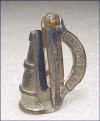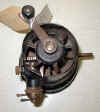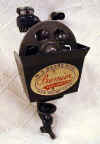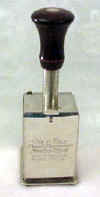Antique Pencil Sharpeners
This page and a number of other pages on this website have photos that show pencil sharpeners and staplers in motion to enable you to see how they work. You can see the movement if you use the Firefox browser. Unfortunately, it appears that the newest version of Internet Explorer no longer recognizes the HTML code used for these moving pictures. I do not know about other browsers.
Until the early 20th century, the most common method of sharpening pencils was whittling with a pen knife. Small handheld pencil sharpeners were popular beginning in the mid-19th century. (Two images immediately below) For our exhibit of Small Pencil Sharpeners from 1837 to 1915, click here.
 
Left: Eureka Pencil Sharpener, patented 1869
Right: Simplex Sharpener No. 650, Eagle Pencil Co., New York, NY, patented 1906
Between the 1880s and 1910s, numerous inventors and companies took up the challenge of supplying offices, schools, draftsmen, artists, and eventually homes with efficient machines to sharpen lead pencils. This work commenced in earnest shortly after mass production of wood-cased lead pencils with round leads began in the late 1870s. (Click here to read about the history of lead pencils.) In the US, the period of innovation virtually ended in the mid-1910s, when pencil sharpeners employing twin planetary cylinders with spiral cutting edges (image to right) drove from the market machines with numerous alternative sharpening technologies that had co-existed for as long as twenty-five years. On the European continent, sharpeners with different technologies continued to be sold as late as the 1960s.
While a handful of mechanical pencil sharpeners were patented in the U.S. between 1860 and 1880, scores of machines were introduced between 1884 and 1915. During this three-decade period, commercially successful mechanical sharpeners embodied a wide variety of approaches to the central problems involved in sharpening a pencil, namely, to remove wood from the point and sharpen the lead, and either to rotate the pencil or to rotate the cutter around the pencil, all without breaking the lead.
Antique mechanical pencil sharpeners can be divided into three categories based on the cutting medium or mechanism. One category of antique pencil sharpener relies on abrasive media such as sandpaper or a steel file. Other machines use a steel milling cutter with multiple cutting edges. Yet other machines use from one to a dozen or more blades. A few used two of these methods. For example, the 1900 Challenge pencil sharpener simultaneously used a blade to cut the wood and sandpaper to sharpen the lead.
|
|
|
Abrading Machines
|
|
| The Gould & Cook Gem Pencil Sharpener was patented in 1886 and sold until 1918. The Gem uses a rotating sandpaper disk 5.75” in diameter to sharpen the pencil. When you turn the crank, both the sandpaper disk and the pencil rotate. This large antique pencil sharpener is 7.75” tall and weighs 5 lb. 4 oz. |

Gem Pencil Sharpener |
| The Perfect Pencil Pointer was patented in 1890 and sold until the mid-1910s. This antique pencil pointer uses a stationary steel file to sharpen the pencil. You insert the pencil into the chuck, which is mounted in a circular sliding carriage. You then grasp the carriage and press the side of the pencil tip against the file. As you slide the carriage along the horizontal wooden shaft, the pencil rubs the file and simultaneously rotates. Unlike most early pencil sharpeners, which are made principally of cast iron, the Perfect is made largely of wood. One model is 9.75” long and weighs 10 oz. Another otherwise identical model is longer. At $1 to $1.75, the Perfect was among the least expensive mechanical pencil sharpeners available until the mid-1910s. While the Gem and Perfect remained in production into the 1910s, few new pencil sharpener models that relied on abrasion were introduced after 1900. |

Perfect Pencil Pointer |
|
Machines with Milling Cutters
A large number of early pencil sharpeners used either one or two steel milling cutters with multiple raised cutting edges. The cutters came in a number of shapes, including disks with cutting edges on the face, wheels with cutting edges on the periphery, cones and cylinders. The photo to the right shows the cutter for a Planetary Pencil Pointer. |
 |
| The A. B. Dick Planetary Pencil Pointer was patented in 1896 and sold until the mid-1910s. Unlike the Gem and Perfect, which were designed so that the pencil revolved, this antique pencil sharpener held the pencil stationary while two milling disks described what is known as “planetary motion” around the end of the pencil. Like a planet, which revolves about its own axis while it orbits the sun, the cutters on a Planetary revolve about their axes while they orbit the tip of the pencil. This motion is displayed in the moving picture to the right. The Planetary is 5” tall and weighs 2 lb. 10 oz. |
Planetary Pencil Pointer |
| The first Guhl & Harbeck Jupiter Pencil Pointer is a German machine that was patented in 1897 and marketed in the U.S. until the mid-1910s. This Jupiter is large—13” long, 5 lb. 8 oz., with a 3” diameter reversible rotary cutter-disk with thirty-four cutting edges radiating from the center on each side. Priced at $10 when it was introduced, compared to $2 to $5 for most other pencil sharpeners, this was the most expensive early mechanical pencil sharpener. This model should not be confused with two distinct later models with the same name. |

Jupiter Pencil Pointer |
| The Webster Pencil Sharpener was introduced in 1898 and sold until the mid-1910s. Based on a photograph, one might think this machine was similar to a modern mechanical pencil sharpener. However, the Webster's cutting mechanism is a single planetary disk cutter, and the machine is large—7” tall and 3 lb. 7 oz. The photograph to the right also shows the original wood box in which the Webster was sold. After production of the Webster ceased, the F. S. Webster Co. sold a license to the George B. Graff Co., which marketed the similar Graffco Pencil Sharpener during 1920-28. |

Webster Pencil Sharpener |
| The Lakeside Pencil Sharpener was marketed during 1904-11, although the patent was not issued until 1911. The Lakeside has a 2.75” diameter cylindrical cutting wheel with 60 diagonal cutting edges on the periphery. It was advertised in 1904 as having “Ten times the cutting surface of any other sharpener.” This is another large machine—5 7/8” tall and 3 lb. 14 oz. |

Lakeside Pencil Sharpener |
The Olcott Climax Pencil Sharpener, which was introduced in 1904, was the first pencil sharpener with a cylindrical cutter with spiral cutting edges. The cutting mechanism was planetary. Because this cutting technology has become dominant, arguably this is the most important machine in the history of mechanical pencil sharpeners. However, this technology was not marketed with great success until the 1910s.
 Cylindrical cutter from Olcott Climax Pencil Sharpener Cylindrical cutter from Olcott Climax Pencil Sharpener
"The construction of this machine is based on the theory that pencil sharpening is delicate work. The cutting is done on an entirely new principle, by means of a cylindrical cutter having thereon twelve cutting blades arranged spirally so that the cutting is done from the point of the pencil, straight back. The object of this is to do away with the lateral pressure, or pressure across the point, which is so apt to break the point and which has been the greatest objection to pencil sharpeners in the past. The great speed of this Climax is accomplished by means of an unique arrangement of the gears and cutting blades by means of which 56 shavings, as fine as a hair, are cut from the pencil with a single turn of the crank. Acting upon the principle that it is better to have a good cutter in the first place and grind it occasionally than to be continually buying new cutters, the manufacturers of the Climax have provided an adjusting feature which makes it possible to sharpen the original cutter. It has always been necessary heretofore for such cutters to be cheaply made in order that the renewal cost may not be prohibitive. The Climax method of providing a tool steel cutter and having it ground when dull overcomes this greatest of all objections to pencil sharpeners in the past." (Beach 1905) |

Olcott Climax
Pencil Sharpener |
During 1910-15, seven companies introduced machines with one or two cylindrical cutters like that on the Olcott Climax immediately above, all of which used planetary mechanisms. These machines were sold under the brand names Roneo, Climax (and several other names used by the Automatic Pencil Sharpener Co. (APSCO)), Boston, Louis Myers, Courant, Stewart, and Koh-I-Noor. In the end, two companies survived in the U.S., APSCO and Boston. These two companies accounted for the vast majority of mechanical pencil sharpeners sold in the U.S. for the next several decades. During the 1910s-1930s, APSCO sold more pencil sharpeners than did Boston. However, Boston increased its market share over a period of decades.
The APSCO Climax Pencil Sharpener, a machine with one planetary cylindrical cutter, was introduced in 1912. A second cutter was soon added and the machine was renamed the Climax No. 2 in 1913. While APSCO machines with planetary cylindrical cutters often have patent dates of 1900 to 1907, none was produced before 1912. APSCO purchased the earlier patents that are listed on its machines from Olcott. The Climax is another large machine—5.25” tall and 3 lb. 12 oz. Between 1913 and 1915, APSCO introduced a full range of smaller machines with the same type of cutters, including the Chicago Pencil Sharpener shown above. The various models were aimed at different segments of the market and sold at different prices, ranging from $__ for the Climax Pencil Sharpener down to $1 for the Chicago Pencil Sharpener. |

APSCO Climax
Pencil Sharpener |
|
Machines with Blades
Mechanical pencil sharpeners that used blades did not play a significant role until after 1900. Most but not all of these machines were smaller than the machines discussed above that used milling cutters.
|
|
| The Babcock Duplex Pencil Sharpener was patented in 1900. The pencil is inserted into the chuck on the side of the machine. When the crank on top of the machine is turned with the right hand, the gang of six blades rotates, shaving the pencil, while the chuck holding the pencil revolves. As the cutting proceeds, the cutter is advanced toward the pencil by applying pressure on a feed bar with the left hand. The Duplex is 3” tall. |


Duplex Pencil Sharpener |
| The McDivitt Little Shaver Pencil Sharpener was patented in 1904 and sold under various names until the late 1910s. This machine has a single rectangular steel blade with one beveled edge, like the blade of a chisel, that is attached to a pivoting arm. This machine is 4.5” across, weighs 11 oz., and was originally sold for $1. |

Little Shaver Pencil Sharpener |
APSCO’s U.S. Automatic Pencil Sharpener was the best selling pencil sharpener in the U.S. during 1907-14 and, although seldom advertised after 1914, apparently continued in production until around 1926. This machine has a rotating cutter with three knife blades.
Many machines with this cutting system were produced in Germany and elsewhere on the European continent from around 1914 until the 1960s. |

U.S. Automatic Pencil Sharpener |
| The Beebe Premier Pencil Sharpener, which weighs only 9 oz., was patented in 1910. The Premier has a crank-driven cutter disk with six small blades. |

Premier Pencil Sharpener |
| The New Era Pencil Sharpener was marketed during 1913-15, although the patent was awarded in 1916. The New Era is one of several pencil sharpeners introduced during 1906-13 that had circular blades. The New Era has a vertical plunger like a numbering stamp. When the plunger is pushed, the blade removes a slice from the pencil tip and then rotates a small amount so that a different part of the blade is used for the next cut. In addition, each time the plunger is pushed, small metal clips inside the device sharpen the blade, and the pencil rotates. While the device is 6.75” tall, the base is only 2.25” x 2.5.” |

New Era Pencil Sharpener |
|
The Everett Pencil Sharpener was patented in 1909 and introduced in 1910. A single blade reciprocates when the crank is turned. For a video clip of this machine in action, see the top of the present page.
|

Everett Pencil Sharpener |
| Please click on the following links to view the Museum's extensive exhibits of early mechanical pencil sharpeners, which are arranged chronologically: 1860-1890s, 1900s, 1910s, 1920-1950s. We also have an exhibit covering electric pencil sharpeners, and an exhibit of pencil sharpener imposters or machines that are sometimes incorrectly identified as pencil sharpeners. |
. |
Exhibit Notes:
1. Prior works presenting systematic information about early pencil sharpeners are few: “Pencil Sharpeners,” Scientific American, Dec. 20, 1913, pp. 478-79; Howard Levin, “The Mechanical Pencil Sharpener: Part One–Manufacturing Milestones from the Late 1800’s,” ToolTalk, Winter 1997, pp. 4-6, and “Part Two–Manufacturing Milestones from 1900–1912,” ToolTalk, Summer 1997, pp. 6-7.
2. The Babcock Duplex Pencil Sharpener was photographed at The National Museum of American History, Smithsonian Institution, Washington, DC. |
. |
Buy purchase buying purchasing sell selling antique vintage early victorian old pencil sharpener sharpeners pointer pointers for sale
|
|
© Copyright 2000-2016. All material on the Early Office Museum web site is copyrighted. All rights are reserved.
First, you must not plagiarize our material. Plagiarism is the act of passing off as your own the words, photographs, or other work of someone else. That is, not giving appropriate credit. Second, you must not violate our copyright, which means you may not use any images or text from the Early Office Museum web site in publications, in direct mailing material, on web sites, in auction listings, or anywhere else without written permission from the Curator. In some cases, images belong to someone else, and we cannot give permission. If you make a non-infringing use of information from this web site, please cite the Early Office Museum and provide a link or our web address (www.officemuseum.com or www.earlyofficemuseum.com). If you believe that we have not given appropriate credit for your work or have violated your copyright, please email the curator so we can resolve the matter.
|
|